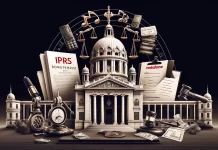(This article is co-authored with Sangita Sharma, a 3rd -year student from Gujarat National Law University, Gandhinagar.)
Who Came Together and Why? (Facts of the Case) –
“Come together and fight” generally has a positive intuitive appeal, but these intuitions change when the same happens before the court(s) between the plaintiffs and defendants. This happened recently in Universal City Studios Llc. & Ors Vs. 123 Movieshub.Tc & Ors where six plaintiffs namely (i) Universal City Studios LLC., (ii) Warner Bros. Entertainment Inc., (iii) Columbia Pictures Industries, Inc., (iv) Netflix Studios, LLC, (v) Paramount Pictures Corporation and (vi) Disney Enterprises, Inc. came together and filed a case against forty-five defendants, forty-three out of which were anonymous rogue websites. They came together on the ground that they have been affected by these rogue websites on account of the unlawful streaming of their works. They also highlighted the payment of separate court fees which makes their case maintainable. However, the Court outrightly rejected these arguments and made the following important remarks:
(1.) “They (Plaintiffs) may have a common grievance against the defendants for uploading and streaming their copyrighted work without authority or license, but the similarity in reliefs claimed against the defendants would not suffice for the plaintiffs to join hands in a single action.” (para 13)
(2.) Owing to the distinct nature of plaintiffs’ works (as the Court said “unidentical works”), there is no common cause of action.
(3.) Paying requisite court fees cannot validate what is not within the procedure prescribed. (para 15)
Nonetheless, given the impending harm to the plaintiffs by the rogue websites most of which are anonymous and pseudonymous, the Court allowed the suit (using its inherent powers) and granted dynamic injunctions. The present post is limited to whether the plaintiffs being separate entities, having separate copyrighted works, can come together and file a single suit for their copyright infringement against the defendants.
Let’s know the Law!
The case, in simple words, is about a situation where something (like the joinder of plaintiffs) which is (claimed to be?) conceptually impossible can be made judicially possible. Here, the plaintiffs invoked Order 1 Rule 1(a) and (b) of the Civil Procedure Code, 1908 which specify who all can be joined as plaintiffs. It sets forth grounds for the parties that may be joined together as plaintiffs. Specifically, there are two conditions laid down, a) where the right to claim relief should arise out of the same act or same transaction or arise out of a series of acts or transactions upon which the suit rests. Second, if separate suits are filed then there would arise a common question of law or fact. These two conditions are to be read in conjunction.
However, without explicating the applicability of these provisions in detail, the Court held that suit in the instant case didn’t fall under the ambit of Order 1 Rule 1 of CPC as the works of the plaintiffs infringed by the defendants are not identical, but Court can allow it using its powers.
Finally, Can they come together? (Analysis)
First of all, a court cannot dismiss such suit(s) (as also noted by the present Court) as Order 1 Rule 9 states that no suit is liable to be dismissed because of misjoinder of parties. Rather, it is considered to be a mere irregularity which is covered by sections 99 and 99-A of the Code. Section 99 states that “No decree shall be reversed or substantially varied, … on account of any misjoinder .. of parties …” Order 1 Rule 10 brings further clarity in this regard by stating that when there seems to be misjoinder of parties, the name of the improperly joined plaintiff … may be struck-out and the case may be proceeded as usual.”
Hence, it is clear that such common suits are generally ordered for separate trials and not dismissed. At the same time, the Court also has the power to hear such a suit if it deems fit. However, the bigger question (or concern!) is regarding the scope of this provision and whether in the present case (or in cases involving similar facts), Court(s) needs to use its powers or a careful consideration of the statute can make it conceptually possible.
In our opinion, the law is sufficiently clear and courts do not need to apply their discretion. Relevantly, both the points of Rule 1 order 1 (a) and (b) are satisfied here. This is apparent from the provision, first (a) rights arise out of the same act or same transaction – in the present case, the right(s) of the plaintiffs arising out of the same act/transaction(s) of the defendants i.e. uploading the copyrighted works of the plaintiffs on their websites. Hence, the act of unauthorized uploading is the same for all the plaintiffs. However, one may argue that since all the plaintiffs are separate entities owning separate (unidentical) works having separate rights on them, the infringement of their work would constitute a separate cause of action and their right to relief would not come from the same act/transaction.
This argument falls flat in the light of Annam Adinarayana And Anr. vs State Of Andhra Pradesh And Anr., (1957) where the Andhra Pradesh Court, clarified that even though the right to the relief claimed does not arise from the same act or transaction, but the petitioners are jointly interested in the causes of action, one petition is maintainable at their instances (para 10). Thus, even if it is assumed that the plaintiffs’ claims did not arise from the same act/transaction, they all are jointly interested in the causes of action. This is evident from the fact that if these rogue websites are shut or not shut, it will affect the right of all of them.
Likewise, in Ramchand Nihalchand Advani vs Anandlal Bapalal Kothari And Anr. (1961) the Gujarat High Court noted (para 19) – “… For if the right or claim arose out of the same act or transaction or series of acts or transactions and if separate actions were brought by them and if in such a case common questions of law or fact would arise, then the joinder of the plaintiffs would be in order under O. 1, R. 1, C.P. Code notwithstanding the fact that the claim or the right in question was severally vested in each of them or in other words distinctly and individually vested in each of the joining plaintiffs. Simply, this case clarifies that even though plaintiffs have different rights concerning their works, the joinder of plaintiffs is valid.
Second (b), the same question of law and fact – if suits were filed separately (i.e. 8 suits by 8 plaintiffs against all the defendants), all suits would have had a common question(s) of law and fact. And that question of fact would have been – whether the defendant is a rogue website and unauthorizedly uploaded the works owned by the plaintiff(s) or whether the defendants are identifiable. And the question of law would have been- whether such unauthorized uploading infringes the copyright of the plaintiffs as given under Section 14. Interestingly, this point is given more weightage than the first point of ‘right to relief arising out of same acts/transactions’.
For instance, in Shambhoo Dayal vs. Chandra Kali Devi, (1964) Allahabad High Court noted that “… it is possible for three plaintiffs to be joined in one suit even on the basis of different causes of action, provided any common question of law or fact would arise if the suit had been filed separately.” (Para 3) Similarly, the Bombay High Court in Krishna Laxman Yadav and Ors. vs. Narsinghrao Vithalrao Sonawane and Anr. (1972), observed that, “…The result of the provisions of Order 1, Rule 1 of the Civil Procedure Code is that where the right to relief exists in favor of several plaintiffs as a result of the same transaction even if the right is several the plaintiffs would be entitled to join in the same suit for the several reliefs the only precondition being that common
question of law or fact arose between the plaintiffs….” (Para 12). The same is also clear from the Paikanna Vithoba Mamidwar and Anr. vs. Laxminarayan Sukhdeo Dalya and Anr., (1978) where the Bombay Court remarked that, “It is not, therefore, necessary any more that there must be identity of interest or identity of causes of action. What is necessary is the involvement of common question of law or fact.” (Para 11.)
Funnily, even this common question requirement is not very strict – for e.g in Sitaram Agarwalla v. Rajendra Chandra Bal, (AIR 1956 Assam 7) the Assam High Court held that “It is not necessary that all questions arising in the case should be common to two suits if plaintiffs co – sharers had instituted separate suits. If even one question of law or fact common to both the suits could arise, there would be justification for joinder and the requirement of Rule 1 of Order 1 would be satisfied”. Even the word ‘common’ as mentioned in Order 1 Rule 1 (b) does not mean identical but simply means something having a link with the transactions (see para 14 Basudeo Khaitan And Ors. vs Madan Lal Periwal And Ors.) which in the present case is an infringement of copyrights by unauthorized uploading of works by rogue websites.
Conclusion
Overall, the judgment is good as it allowed the parties to go ahead with the suit. The intention of the present post is not to provide any critique of the judgment, however, it is to highlight and analyse the scope of laws. In the present case, the Court regarded the joinder of plaintiffs as ‘conceptually impossible’ (i.e. outside the purview of the law), but ultimately made it judicially possible (i.e. using its power, or more subtly, its ‘discretion’). We see this as a gap (between what is conceptually impossible and judicially possible) which should always be strived to be minimized.
Image resource – The cover of the book “We All Need To Come Together” by Kira Parris-Moore, Grace Desmarais – here


















![DELHI HIGH COURT RULES IN FAVOUR OF T SERIES & SAREGAMA IN COPYRIGHT INFRINGEMENT CASE AGAINST RADIO BROADCASTERS FOR VIOLATION OF RULE 29 OF COPYRIGHT RULES [READ JUDGEMENT]](https://iprmentlaw.com/wp-content/uploads/2021/11/artworks-000021426043-5d76ou-t500x500-100x70.jpeg)